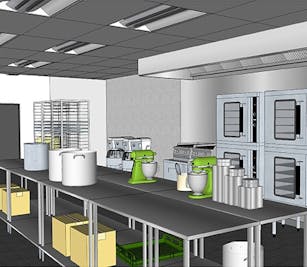
December 5, 2020
The concept of ghost kitchens & delivery-only restaurants has seen a significant uptick in recent popularity since COVID-19 upended the foodservice industry. Naturally, as diners are demanding more take-out and delivered options (a trend that was already occurring pre-pandemic), the reliance on food ordered and delivered solely from smartphones has risen in parallel. Real estate entrepreneurs and venture capitalists took notice quickly, and over the past 18 months have pumped nearly one billion dollars in investment capital to fuel the rise of ghost commercial kitchen facilities. As with all enterprises, investors putting that much capital in are expecting a return. But the real question is, as a potential renter of a ghost kitchen, can you afford to have that ROI come out of your profits?
Is a Ghost Kitchen Really the Answer?
PREP Commercial Kitchens in Austin provides large private and shared commissary kitchen spaces for rent, which can be used for all sorts of food production – from ghost restaurants to catering, baking, specialty food production, prepared meals and more. We’re much more than just your average small space in which to grind it out day after day hoping to survive on delivery alone. Our spacious kitchens, housed in a collaborative and engaged food community, will satisfy your needs both while you’re getting started and as you grow.
Here are four key reasons to consider PREP over a standard ghost kitchen:
1. We offer a significantly larger space.
Our shared and private kitchens offer more than double the amount of space of an average ghost kitchen. The ample space opens doors for expansion, but most importantly PREP allows you to run multiple concepts, develop multiple revenue streams, and handle large-scale catering so that you can drive your sales up across multiple channels.
2. Members of PREP spend half as much on rent on average.
In a comparative analysis of similar businesses, food service providers working with PREP Commercial Kitchens spend nearly fifty percent less on rent than those using a traditional ghost kitchen. Those savings on your occupancy costs really matter, especially as the delivery world becomes more and more competitive.
3. PREP provides access to partners and vendors that save you money.
Our food collective allows for buying power that you could not achieve on your own in a free-standing ghost kitchen. Our partner relationships enable members to purchase ingredients, supplies, technology, and delivery services at lower prices so that operators can keep more of the revenue they earn.
4. We support your enterprise and will never use your data against you.
Unlike other providers, we will never capture, retain, or use our members' sales data to build a food service business or assist another in doing so.
Our operation aims to see economic surges on the local level. We represent more than just a space for rent. We hope to provide an environment that allows you to develop and expand your brand's vision successfully. If you’re looking for an affordable way to launch or grow your business in a supportive environment, reach out to us today!
Subscribe to Our Newsletter For More Updates
A ghost kitchen is defined as a commercial kitchen that is rented without any directly attached retail dining area. The sizes of most ghost kitchens are typically around 200sf, and they’re pitched as a means for anyone interested in a spinning up a strictly take-out or delivery concept to do so in a quick, efficient manner.
However, what may be sold as a low cost, turn-key kitchen may not be entirely what you'd expect. More often than not the capital required for opening costs will be hefty, and the ongoing operating costs may make it challenging to turn a profit. Some ghost kitchens do not contain equipment out of the box, which could add as much as $50,000+ to your initial opening costs. Also, rent can be exorbitant, particularly in high traffic urban areas. Would you be able to afford potentially paying more than $8,000 per month for 250 square feet with a minimum one-year guaranteed contract? The terms of many of these contracts also include onboarding fees and significant security deposits.
Labor costs are of course lower in a delivery/take-out ghost kitchen operation, but they must be carefully balanced to match your estimated delivery sales and can come become difficult if you try to run during multiple dayparts or hire your own delivery people. The alternative delivery mechanism is usually even worse than that, as third-party delivery programs will also eat away at twenty-five to fifty percent of your ticket value on average.
When you break all the costs items down, at the end of the day according to QSR magazine, a brand that uses a ghost kitchen will need about $650,000 in sales to break even for the year. That represents a lofty goal — even for already established brands but certainly for smaller operators without a large built-in audience to drive demand.
So with all these challenges, you might be asking yourself what the path to making a ghost or virtual restaurant work is……


Member Login
Follow us on social media
© 2020 by Culinary Facilities of Texas, LLC. All rights reserved.
PREP Commercial Kitchens is Your Solution






